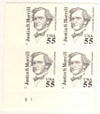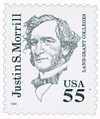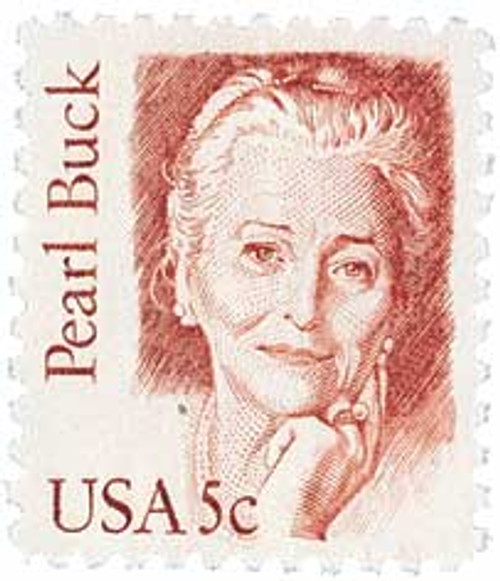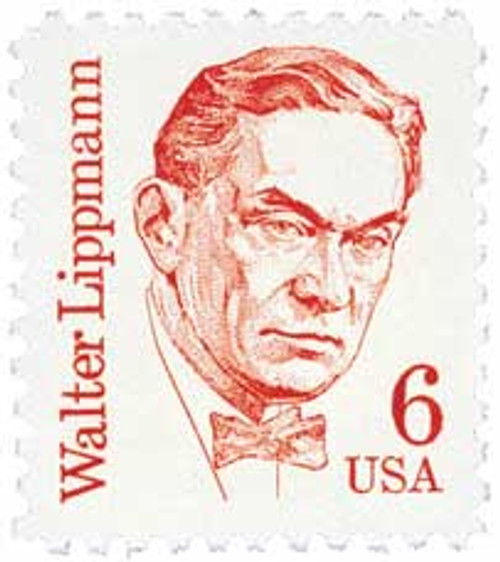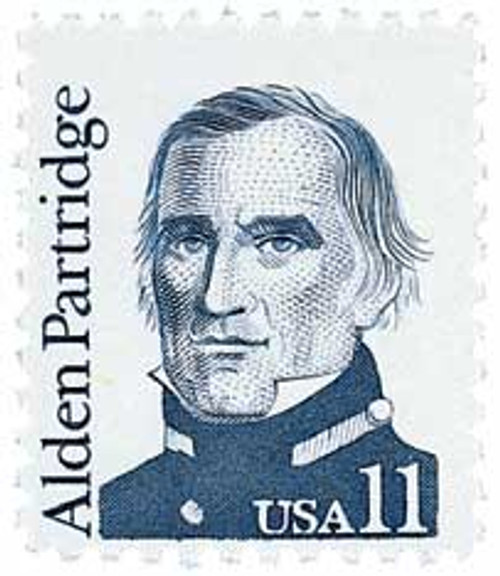
# 2941 - 1999 55c Great Americans: Justin S. Morrill
US #2941
1999 Justin Morrill
- 63rd and final stamp in the Great Americans series
- Second self-adhesive stamp in series
- Honors “the father of land grant colleges”
Category of Stamp: Definitive
Set: Great Americans
Value: 55¢, First-Class mail weighing one to two ounces
First Day of Issue: July 17, 1999
First Day City: Strafford, Vermont
Quantity Issued: 100,000,000
Printed by: Banknote Corporation of America
Printing Method/Format: Engraved. Pane of 20 from plates of 240 (12 across, 20 down)
Perforations: Die Cut (11.7 X 11.5)
Color: Black
Reason the stamp was issued: This stamp honors Justin Morrill, a US congressman from Vermont who sponsored the 1862 Act of Congress that established land grant colleges. It was issued to pay the rate for First-Class mail weighing between one and two ounces. The Morrill stamp also paid for 1-ounce letters to Canada or postcards to any nation except Canada and Mexico.
About the stamp design: Burt Silverman is the artist who created the pen and ink portrait used for the Justin Morrill stamp. The artist based his work on a photograph of Morrill.
First Day City: The First Day of Issue ceremony took place in Morrill’s hometown of Strafford, Vermont.
Unusual thing about this stamp: A Justin Morrill stamp was intended to be part of the Great Americans series since 1984. A die and transfer roll with his image and a 24¢ denomination were created by the Bureau of Engraving and Printing in anticipation of a rate increase. The rate changed to 25¢, so the stamp was put in storage. In 1998, the US Postal Service chose to use the Silverman illustration of Morrill for a new 55¢ stamp. A new die had to be engraved for Banknote’s printing press.
About the Great Americans series:
The Great Americans Series was created to replace the Americana Series. The new series would be characterized by a standard definitive size, simple design, and monochromatic colors.
This simple design included a portrait, “USA,” the denomination, the person’s name, and in some cases, their occupation or reason for recognition. The first stamp in the new series was issued on December 27, 1980. It honored Sequoyah and fulfilled the new international postcard rate that would go into effect in January 1981.
The Great Americans Series would honor a wider range of people than the previous Prominent Americans and Liberty Series. While those series mainly honored presidents and politicians, the Great Americans Series featured people from many fields and ethnicities. They were individuals who were leaders in education, the military, literature, the arts, and human and civil rights. Plus, while the previous series only honored a few women, the Great Americans featured 15 women. This was also the first definitive series to honor Native Americans, with five stamps.
The Bureau of Engraving and Printing (BEP) produced most of the stamps, but private firms printed some. Several stamps saw multiple printings. The result was many different varieties, with tagging being the key to understanding them. Though there were also differences in perforations, gum, paper, and ink color.
The final stamp in the series was issued on July 17, 1999, honoring Justin S. Morrill. Spanning 20 years, the Great Americans was the longest-running US definitive series. It was also the largest series of face-different stamps, with a total of 63.
History the stamp represents:
Born in Strafford, Vermont, Justin S. Morrill was a powerful US political leader. He served Vermont as a congressman from 1855-67 and as a senator from 1867-98. Morrill introduced the Morrill Tariff Act of 1861, and was key to the formation of the Republican Party and in passing the legislation that formed the Library of Congress.
Morrill is best remembered for the Morrill Act of 1862, which established land-grant colleges and universities. The idea was based on the first land-grant institutions established on the state level in February 1855. The Agricultural College of the State of Michigan was granted 14,000 acres of state land on February 12. Ten days later, the Farmer’s High School of Pennsylvania was re-established as the Pennsylvania State University. Together, they served as the model for the Morrill Act of 1862.
Morrill introduced his first land-grant bill to Congress in 1857. Its purpose was to offer a course of study that wasn’t based on either abstract liberal arts or on military science, which were the primary focuses of higher education during the 1800s.
According to Morrill, “This bill proposes to establish at least one college in every State upon a sure and perpetual foundation, accessible to all, but especially to the sons of toil, where all of needful science for the practical avocations of life shall be taught, where neither the higher graces of classical studies nor that military drill our country now so greatly appreciates will be entirely ignored, and where agriculture, the foundation of all present and future prosperity, may look for troops of earnest friends, studying its familiar and recondite economies, and at last elevating it to that higher level where it may fearlessly invoke comparison with the most advanced standards of the world.”
Morrill’s bill was passed in 1859 but vetoed by President Buchanan (who also vetoed the Homestead Act). Morrill resubmitted the bill in 1861 and it again was passed. On July 2, 1862, President Abraham Lincoln signed the Morrill Act into law. The first “land-grant college” created under the act was Kansas State University – established February 16, 1863.
The act gave each state 30,000 acres of Federal land for each of its senators and congressmen. The states had the option of developing the property or selling it to raise funds to establish “land-grant” colleges. Land grant colleges, which featured courses on practical agriculture, science, and engineering, were a response to the industrial revolution. States that had seceded from the Union were not eligible to take advantage of the Morrill Act. The act also added military science and tactics to these studies. Thirty states used the money to start new agricultural and mechanical colleges. Eighteen states gave the money to existing state universities to form agricultural and mechanical departments. Three states gave the money to private universities. The University of California and University of Illinois are two of the best-known land-grant colleges.
A second Morrill Act was passed in 1890. Aimed at the Southern states, the act required each state to show that race wasn’t a consideration for admission, or to establish a separate land-grant college for African Americans. Over 100 years later, land grant colleges for Native Americans were introduced. More recently, the concept has been developed to fund universities for aquatic, urban, space, and sustainable energy research.
US #2941
1999 Justin Morrill
- 63rd and final stamp in the Great Americans series
- Second self-adhesive stamp in series
- Honors “the father of land grant colleges”
Category of Stamp: Definitive
Set: Great Americans
Value: 55¢, First-Class mail weighing one to two ounces
First Day of Issue: July 17, 1999
First Day City: Strafford, Vermont
Quantity Issued: 100,000,000
Printed by: Banknote Corporation of America
Printing Method/Format: Engraved. Pane of 20 from plates of 240 (12 across, 20 down)
Perforations: Die Cut (11.7 X 11.5)
Color: Black
Reason the stamp was issued: This stamp honors Justin Morrill, a US congressman from Vermont who sponsored the 1862 Act of Congress that established land grant colleges. It was issued to pay the rate for First-Class mail weighing between one and two ounces. The Morrill stamp also paid for 1-ounce letters to Canada or postcards to any nation except Canada and Mexico.
About the stamp design: Burt Silverman is the artist who created the pen and ink portrait used for the Justin Morrill stamp. The artist based his work on a photograph of Morrill.
First Day City: The First Day of Issue ceremony took place in Morrill’s hometown of Strafford, Vermont.
Unusual thing about this stamp: A Justin Morrill stamp was intended to be part of the Great Americans series since 1984. A die and transfer roll with his image and a 24¢ denomination were created by the Bureau of Engraving and Printing in anticipation of a rate increase. The rate changed to 25¢, so the stamp was put in storage. In 1998, the US Postal Service chose to use the Silverman illustration of Morrill for a new 55¢ stamp. A new die had to be engraved for Banknote’s printing press.
About the Great Americans series:
The Great Americans Series was created to replace the Americana Series. The new series would be characterized by a standard definitive size, simple design, and monochromatic colors.
This simple design included a portrait, “USA,” the denomination, the person’s name, and in some cases, their occupation or reason for recognition. The first stamp in the new series was issued on December 27, 1980. It honored Sequoyah and fulfilled the new international postcard rate that would go into effect in January 1981.
The Great Americans Series would honor a wider range of people than the previous Prominent Americans and Liberty Series. While those series mainly honored presidents and politicians, the Great Americans Series featured people from many fields and ethnicities. They were individuals who were leaders in education, the military, literature, the arts, and human and civil rights. Plus, while the previous series only honored a few women, the Great Americans featured 15 women. This was also the first definitive series to honor Native Americans, with five stamps.
The Bureau of Engraving and Printing (BEP) produced most of the stamps, but private firms printed some. Several stamps saw multiple printings. The result was many different varieties, with tagging being the key to understanding them. Though there were also differences in perforations, gum, paper, and ink color.
The final stamp in the series was issued on July 17, 1999, honoring Justin S. Morrill. Spanning 20 years, the Great Americans was the longest-running US definitive series. It was also the largest series of face-different stamps, with a total of 63.
History the stamp represents:
Born in Strafford, Vermont, Justin S. Morrill was a powerful US political leader. He served Vermont as a congressman from 1855-67 and as a senator from 1867-98. Morrill introduced the Morrill Tariff Act of 1861, and was key to the formation of the Republican Party and in passing the legislation that formed the Library of Congress.
Morrill is best remembered for the Morrill Act of 1862, which established land-grant colleges and universities. The idea was based on the first land-grant institutions established on the state level in February 1855. The Agricultural College of the State of Michigan was granted 14,000 acres of state land on February 12. Ten days later, the Farmer’s High School of Pennsylvania was re-established as the Pennsylvania State University. Together, they served as the model for the Morrill Act of 1862.
Morrill introduced his first land-grant bill to Congress in 1857. Its purpose was to offer a course of study that wasn’t based on either abstract liberal arts or on military science, which were the primary focuses of higher education during the 1800s.
According to Morrill, “This bill proposes to establish at least one college in every State upon a sure and perpetual foundation, accessible to all, but especially to the sons of toil, where all of needful science for the practical avocations of life shall be taught, where neither the higher graces of classical studies nor that military drill our country now so greatly appreciates will be entirely ignored, and where agriculture, the foundation of all present and future prosperity, may look for troops of earnest friends, studying its familiar and recondite economies, and at last elevating it to that higher level where it may fearlessly invoke comparison with the most advanced standards of the world.”
Morrill’s bill was passed in 1859 but vetoed by President Buchanan (who also vetoed the Homestead Act). Morrill resubmitted the bill in 1861 and it again was passed. On July 2, 1862, President Abraham Lincoln signed the Morrill Act into law. The first “land-grant college” created under the act was Kansas State University – established February 16, 1863.
The act gave each state 30,000 acres of Federal land for each of its senators and congressmen. The states had the option of developing the property or selling it to raise funds to establish “land-grant” colleges. Land grant colleges, which featured courses on practical agriculture, science, and engineering, were a response to the industrial revolution. States that had seceded from the Union were not eligible to take advantage of the Morrill Act. The act also added military science and tactics to these studies. Thirty states used the money to start new agricultural and mechanical colleges. Eighteen states gave the money to existing state universities to form agricultural and mechanical departments. Three states gave the money to private universities. The University of California and University of Illinois are two of the best-known land-grant colleges.
A second Morrill Act was passed in 1890. Aimed at the Southern states, the act required each state to show that race wasn’t a consideration for admission, or to establish a separate land-grant college for African Americans. Over 100 years later, land grant colleges for Native Americans were introduced. More recently, the concept has been developed to fund universities for aquatic, urban, space, and sustainable energy research.






